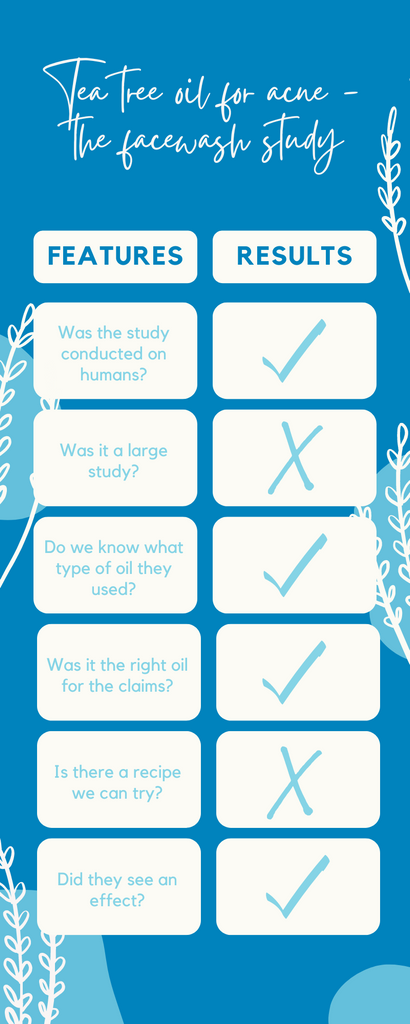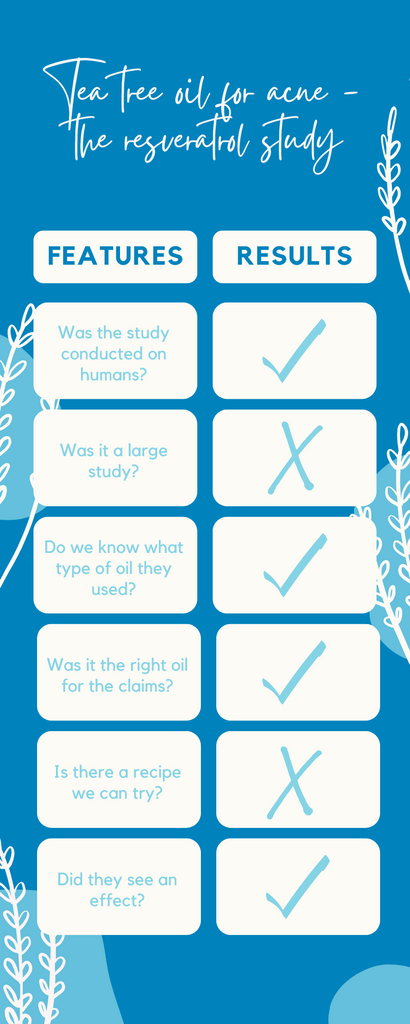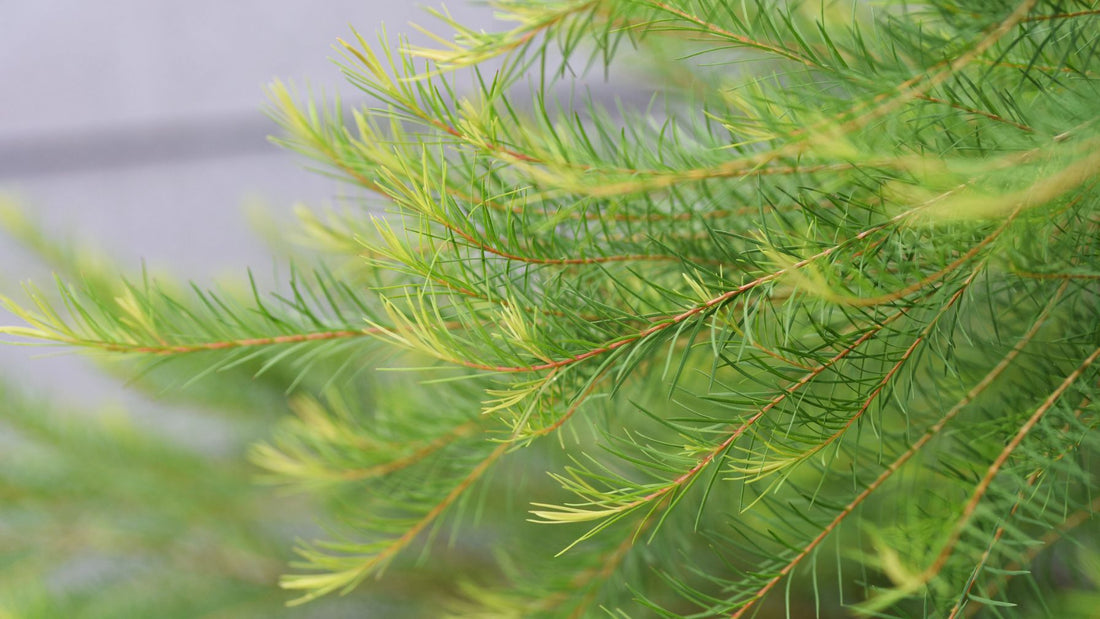Acne can be frustrating. So can the influx of advice on how to treat it. That’s why instead of giving you vague tips for clearing your skin, we’re giving you the evidence for one of the most popular natural treatments out there: tea tree oil for acne.
If you go to the skincare section of any supermarket, you’re likely to see skincare products with tea tree marketed at oily and acne prone skin. Acne tea tree oil products are even said to be as effective as popular prescribed acne treatments.
The claimed benefits of tea tree essential oil usually draw on its antibacterial properties, which make for an effective deep-cleaning soap. There are also claims that tea tree can help treat acne because it has anti inflammatory properties, and inflammation does have a role in acne
But, as we know after our previous post, claims aren’t enough.
Let’s pick and pop the studies to find out what we really know about tea tree oil for acne, so you can decide whether or not to try it yourself.
Contents
- The tea tree gel study
- Tea tree oil - the antibacterial study
- Tea tree oil vs erythromycin study
- Tea tree oil vs benzoyl peroxide study
- Tea tree face wash study
- Tea tree oil and oily skin study
- Conclusion
Tea tree oil for acne studies
These frequently referenced studies look at tea tree for reducing acne, how it works in comparison to other acne treatments, and for the skin in general.

1. Tea tree oil as an alternative acne medicine
This review looks at the rise in alternative medicines for treating acne, such as herbal medicine, acupuncture, dietary modifications, and, of course, tea tree oil.
It mentions a study of patients with moderate to severe acne, where tea tree oil was found to make a significant difference in the severity of acne compared to a placebo.
How many people took part in the study?
There were only 60 participants.
Which tea tree oil did they use?
They used tea tree essential oil, although it isn’t specified whether it was a Chinese or Australian tea tree. That said, their oil conforms to the ISO standard which means it will be similar to ours.
Did they give a treatment recipe?
Kind of – they used 5% tea tree oil in an unspecified gel.
How much treatment was applied?
The treatment was left on for 20 mins and washed off, twice a day, for 45 days.
KEY TAKEAWAY: the review and study suggest that tea tree oil may reduce the appearance of acne, although it isn’t great quality evidence.

2. Tea tree oil and acne causing bacteria
This study explored the antimicrobial effects of eleven plant oils against acne causing bacteria. The winners? Tea tree oil and rosemary oil.
How many people took part in the study?
Again, this study had a small sample size of 55 participants.
Which oil did they use?
They used tea tree oil diluted in Dimethyl Sulfoxide (DMSO) to between 9.7mg/L 500mg/L. The minimum effective dose was measured at 78 mg/L.
Did they give a treatment recipe?
Yes, and a detailed one too, but you probably don’t keep dimethyl sulfoxide at home so it’s not one you can easily repeat.
How much treatment was applied?
Bacteria were extracted from the participant’s acne spots (nice!) and studied in the lab. Tea tree oil was found to kill the bacteria within 4 hours.
KEY TAKEAWAY: the study shows that diluted tea tree oil can kill acne bacteria in a lab, which is promising, but not what it will do when applied to your skin, which won’t necessarily be the same.

3. Tea tree oil vs. erythromycin cream
In a study that compared a propolis, tea tree oil, and aloe vera treatment to erythromycin, an antibiotic cream, the natural formula was more effective in reducing acne scars and severity.
How many people took part in the study?
You guessed it – a small sample of 60 people.
Which tea tree oil did they use?
They used a cream made of 20% propolis, 3% tea tree oil, and 10% aloe vera juice.
Did they give a treatment recipe?
They gave the active ingredients, but that’s it, so it would be tricky to replicate the acne spot treatment at home.
How much treatment was applied?
The spot treatment was applied twice a day, for 30 days.
KEY TAKEAWAY: The natural ingredients proved to be an effective alternative to popular acne fighting products, but the effects may not be caused by the tea tree oil alone.

4. Tea tree oil vs benzoyl peroxide
In this study, tea tree oil was found to be effective in reducing the number of acne lesions, working a little slower than benzoyl peroxide, a popular topical acne treatment.
How many people took part in the study?
There were 124 participants, which is better than the other studies on our list, but still not great.
Which oil did they use?
They used tea tree oil diluted to 5% in a gel.
Did they give a treatment recipe?
No.
How much treatment was applied?
We don’t get to find this out either!
KEY TAKEAWAY: The research suggests 5% tea tree oil could be useful in treating acne, but the lack of details means the recipe and method are hard to follow at home.

5. Tea tree oil skincare study
When it comes to acne that’s not too bad, this study found that a tea tree gel and face wash can help. The study measured the change in the appearance of mild to moderate acne and involved a questionnaire on skin reactions and how participants found the products.
How many people took part in the study?
Only 14 participants.
Did they give a treatment recipe?
Strangely, the tea tree oil gel and face wash aren’t named in the study. This makes the evidence less reliable because you can’t replicate it at home – and the ‘product acceptability’ questionnaire is pretty much pointless!
How much treatment was applied?
The treatment was applied twice daily for 12 weeks, but we don’t know how long the gel was left on the skin.
KEY TAKEAWAY: This evidence can’t be relied on because of the very small number of participants. To be blunt, ignore it.

6. Tea tree oil for oily skin
Oily skin is a contributing factor to acne, not to mention the excess shine and increased pores that come with it. In this study, resveratrol (an antioxidant compound found in certain plants) and tea tree oil were found to improve the oiliness of the skin.
How many people took part in the study?
If you thought the 14 in the previous study was small, it gets worse – this study only has 5 participants!
Which tea tree oil did they use?
They used a combination of resveratrol and tea tree oil. This means that any results could – and are very likely to – be down to the resveratrol, which has been found to be effective against acne.
KEY TAKEAWAY: This study demonstrates a combination of two products that can help reduce oily skin. It can’t, however, be considered evidence that tea tree oil helps reduce acne.

Conclusion: does tea tree oil work for acne prone skin?
Although there’s lots of anecdotal evidence of diluted tea tree oils being good for acne prone and sensitive skin too, it’s not a clear-cut yes. There are studies to support them, which we’ve unpicked in this post, but a lot are low quality due to small sample sizes and unclear formulas.
Overall, the claims are promising, but not proven.
Just remember that pure tea tree oil needs to be diluted, and you shouldn't apply tea tree oil directly to your skin without diluting it in a carrier oil. We recommend a maximum 15% dilution.
Continue reading
- Interested in learning more about essential oils? Find out the best 7 essential oils for uplifting mood
- Want to learn how to make a face oil? Try our rosehip face oil recipe
- Looking for a gentle cleanser for your skincare routine? Try our face cleansing balm recipe
Did you find that tea tree oil helped improve acne prone skin? Comment below and let us know.



